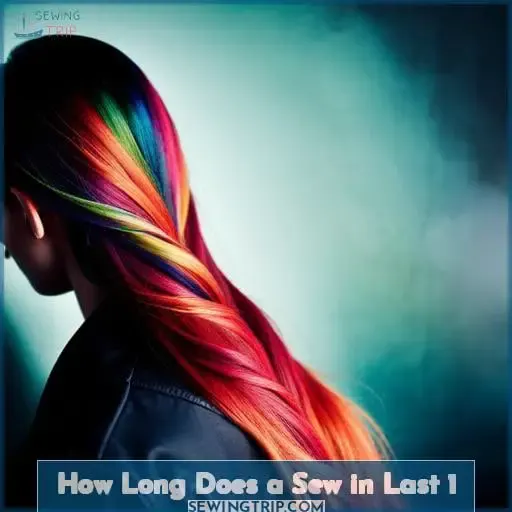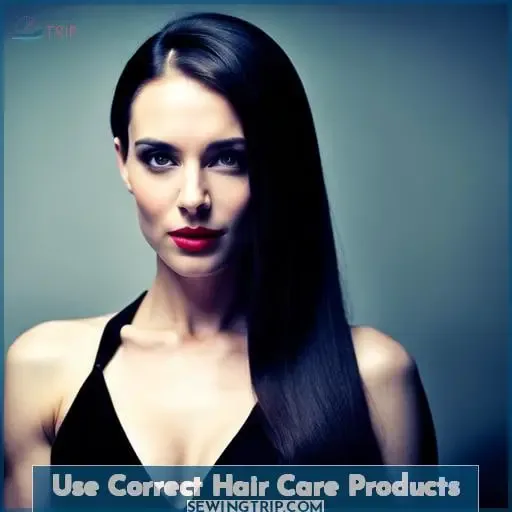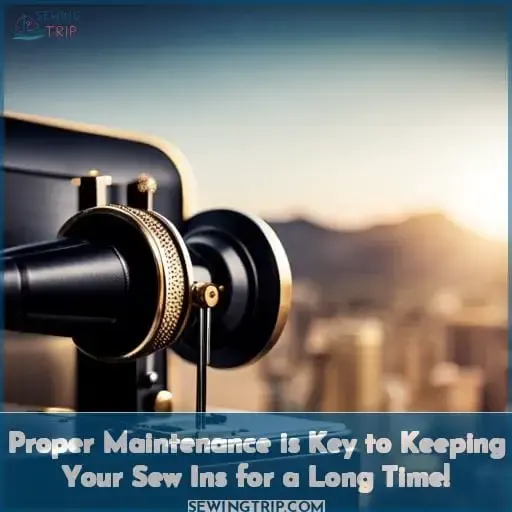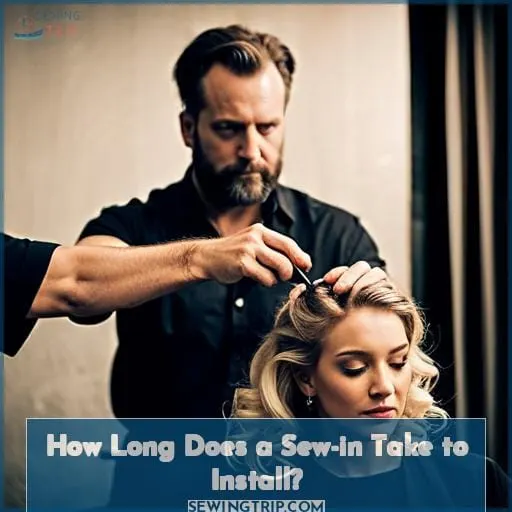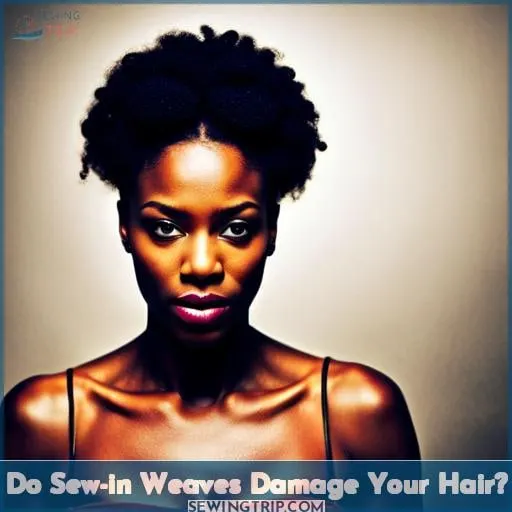This site is supported by our readers. We may earn a commission, at no cost to you, if you purchase through links.
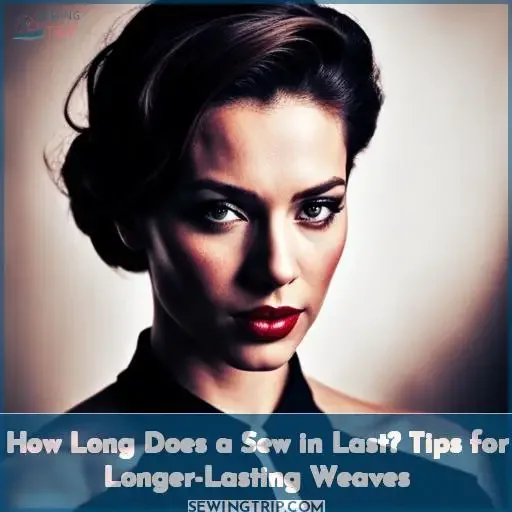 Surprised to hear how long a sew-in can last? Well, you’re not alone! Sew-in weaves are an amazing way of instantly enhancing your look by adding volume and length.
Surprised to hear how long a sew-in can last? Well, you’re not alone! Sew-in weaves are an amazing way of instantly enhancing your look by adding volume and length.
With proper care and maintenance, sew-ins could stay on for up to two months. However, there are certain signs that tell when it’s time for them to go, such as an itching scalp or excessive shedding of hair strands.
Sounds daunting already? Don’t worry; with these tips for longer-lasting weaves, you’ll be able to maintain those extensions like a pro!
Table Of Contents
- Key Takeaways
- About Sew-in Hair Extensions
- How to Put on Sew-in Extensions?
- How Long Do Sew-in Extensions Last?
- Signs It’s Time to Let the Sew-Ins Go
- How to Make Your Sewn-in Extensions Last?
- Use Correct Hair Care Products
- Proper Maintenance is Key to Keeping Your Sew Ins for a Long Time!
- What is a Sew-in?
- How Long Does a Sew-in Take to Install?
- Do Sew-in Weaves Damage Your Hair?
- Frequently Asked Questions (FAQs)
- Conclusion
Key Takeaways
- Sew-in weaves can last up to two months with proper care.
- Quality human hair extensions and proper installation are essential for longevity.
- Regular maintenance and touch-ups are necessary to keep sew-ins looking fresh.
- Using high-quality products, detangling regularly, and avoiding excessive heat styling can help extend the lifespan of sew-in extensions.
About Sew-in Hair Extensions
You can achieve a beautiful, semi-permanent hairstyle with sew-in hair extensions that don’t require clips or adhesives, and they can last up to 12 weeks if you take proper care of them.
Sew-ins are an ideal choice for protective styling since the hair is not exposed to heat or chemical treatments. To maintain your weave and keep it looking fresh for longer periods of time, use quality human hair extensions in combination with regular haircare maintenance.
Detangle your hair before sleeping and wash it every two weeks using sulfate-free shampoo. Additionally, avoid product buildup by brushing regularly with a wide-toothed brush followed by leave-in conditioner.
Avoid overwashing too often, as it may lead to dryness. Applying oils like coconut oil every other day will help retain moisture in your scalp while keeping tangles at bay.
Taking these simple steps will ensure that you get the most out of your sew-ins look without sacrificing its health!
How to Put on Sew-in Extensions?
To achieve a long-lasting sew-in, you must begin by properly preparing your hair. Divide your hair into sections and create cornrows that will serve as the foundation for attaching the weft of extensions.
Once this is completed, use an appropriate needle and thread to securely attach each hair extension, ensuring they remain in place.
Part Your Hair
Start parting your hair now and get ready to flaunt the fabulousness of a full-closure sew-in that will make heads turn! Follow proper installation techniques such as braiding natural locks, using high-quality hair extensions, and avoiding tight sewing or braiding.
Professional washing every two weeks is essential for maintenance. Touch-ups or removal may be necessary if it looks thin due to improper care.
Create a Cornrow
Begin your sew-in journey by creating a foundation of cornrows to make sure your extensions are securely in place. Use braiding techniques and consider the type of closure you’re using. For box braids, start with a tight braid pattern.
After prepping hair properly and selecting high-quality extensions that fit seamlessly into existing natural locks, it’s time to attach the weft! Cornrows work best when weaving through each piece so no strand is left behind.
Attach the Weft by Sewing It In
Once you’ve laid the foundation for your sew-in with cornrows, it’s time to attach the weft by sewing it in.
On average, a properly installed and well-maintained sew-in can last up to 8 weeks or more when cared for correctly. Use threading techniques that provide just enough tension without causing damage. Select quality hair extensions suitable for your desired look. Consider the type of installation techniques such as weaving, crocheting, or braiding before making a final decision on which extension types are best suited.
Make sure the weave is sewn in securely along the base of the braid using the appropriate needle size according to hair thickness. Also, select the correct type of wefts depending on the extra length needed and texture desired.
With proper care – following regular touch-ups, washing, and conditioning regularly – sewn-in extensions may remain intact longer than expected!
How Long Do Sew-in Extensions Last?
Now that you know how to put on sew-in extensions, the next step is understanding how long they last. With proper care and maintenance, a full closure sew-in can last 6–12 weeks or longer! But it’s important to choose high-quality hair extensions and avoid braiding or sewing too tightly.
Consider price, quality, and versatility when selecting your hair extension wefts. Professional washing every two weeks is also recommended, as over-shampooing may lead to dryness which could damage the natural tresses underneath.
Heat styling should be kept to a minimum, so use heat-protecting products whenever necessary for added protection from hot tools like flat irons and blow dryers.
Touch-ups are highly recommended if you notice thinning of your hair volume due to prolonged wear of the weave. This will help fix any minor issues with the install along the way while still extending its lifespan.
Signs It’s Time to Let the Sew-Ins Go
As the days pass, it’s important to be aware of signs that your sew-ins have reached their expiration date. These include an excessively itchy head, oil buildup and smell, unruly hair growth, inclined weaves, and intense shedding of weaves.
If any of these symptoms present themselves during the 6-12 weeks when a full closure sew-in typically lasts for with proper maintenance, then it’s time to let go! Paying attention to these clues can help ensure you maintain healthy hair underneath while still enjoying beautiful extensions on top.
Excessively Itchy Head
If your scalp is itching excessively, it may be time to remove your sew-ins. Hair loss prevention and healthy hair habits are important when wearing closure sew-ins. By removing the extensions, you’ll give your scalp a break from tight braids that can strip it of its natural oils.
Scalp care tips such as using Itchy Scalp Remedies and avoiding over shampooing can help with relief until removal time comes around. Proper maintenance for extended wear includes weekly deep conditioning treatments along with regular visits to the salon for adjustments or touchups if necessary.
Best upkeep also involves wrapping hair before bedtime, using satin pillowcases, and sulfate-free products like Design Essentials Moisture Shampoo or Jane Carter Solution Hydrating Invigorating Shampoo.
Oil Buildup and Smell
You may notice an oil buildup and smell if your sew-ins are past their prime. Preventing this buildup requires proper cleansing with sulfate-free shampoo, conditioning regularly with moisturizing products, and avoiding excessive heat styling.
Quality extensions should also be used to avoid odors from synthetic hair and ensure the best fit for different head measurements. To maintain unruly hair growth, check the quality of your hair extension wefts according to their length.
Lastly, invest in quality products that can help keep these problems at bay while making sure you look beautiful wearing them!
Unruly Hair Growth
To prevent unruly hair growth, check the quality of your extensions according to their length and visit a salon for regular touch-ups or removal when needed. Invest in products that keep problems at bay while making sure you look beautiful wearing them – sew-ins can last up to 12 weeks with proper care! Consider price range as well as quality and versatility when selecting human hair wefts.
Avoid over-shampooing, using excessive heat styling, and tight braiding or sewing; opt instead for sulfate-free shampoo & conditioner plus moisturizing products like Carol’s Daughter Coco Creme Curl Quenching Shampoo.
Ask your stylist plenty of questions before installation about texture variety available so you get the best way to maintain long-lasting results.
Following these general rules will provide an itchy scalp-free environment, minimize smelly oil buildup on weave tracks, and protect against strand breakage from heat styling damage!
Inclined Weaves
Avoid inclined weaves by having your stylist periodically check the tightness of the braided tracks and adjust accordingly. Quality hair extensions, heat protection products, and caring for your sew-in weave are key to preventing hair loss.
Choose a reputable stylist who will help you select the best choice for achieving dream hair.
Full-closure sew-ins should be tightened every 4 weeks to keep them looking flawless. Use a looper brush for detangling and wrap or scarf when sleeping. Moisturize often with sulfate-free shampoo and conditioner.
Opt out of excessive heat styling and maintain pH balance with an apple cider vinegar rinse once a week.
Taking these steps ensures long-lasting results without sacrificing natural locks!
Intense Shedding of Weaves
If you experience intense shedding of your weaves, it may be time to remove them and give your hair a break. Shedding is a regular complaint among those who wear sew-in weaves, but it’s important to note that some amount of natural occurrence is normal.
Causes for excessive shedding include damage from day-to-day activities like brushing or styling too harshly, as well as poor quality hair extensions or improper installation technique. To prevent this issue, opt for high-quality hair extensions with minimal processing and ensure proper care by using the right products, such as sulfate-free shampoos and conditioners twice per week, followed by deep conditioning treatments once per week.
If signs of extreme shedding persist even after taking these steps, consider touch-ups or removal in order to prevent further damage leading to permanent hair loss.
How to Make Your Sewn-in Extensions Last?
To ensure your sewn-in extensions last for the longest possible period of time, it’s essential you practice proper care. Before sleeping and washing your hair, make sure to untangle any knots or mats. This will protect the wefts from pulling and breaking.
Additionally, wrap up all of your hair before bedtime using a silk scarf or soft cloth headwrap that won’t create any friction on the strands.
To keep your extensions looking their best, wash them twice a week with a mild sulfate-free shampoo. It’s also important to deep condition them once per week. Avoid overusing heat styling products.
Taking these steps will help guarantee the maximum longevity of your sewn-in extensions!
Detangle Your Hair Before Sleeping and Washing Them
Detangle your hair every night before bed and when you wash them to keep your sew-in looking fresh and healthy. Use a looper brush or comb for gentle detangling. Invest in quality hair extensions from brands like Mayvenn Hair and seek the help of a reputable stylist for installation.
Use heat-protecting products, moisturizing products, and touch-ups removal if necessary to ensure a long-lasting love affair with your sew-in! Different options are available, so do some research on Julius Nash reviews.
His expertise will make sure that all angles are covered when it comes to choosing the best option for you.
Wrap Your Hair Before Going to Bed
To keep your sew-in looking lush and luxe, wrap your hair in a scarf or headwrap before going to bed. This will help protect the scalp from friction while sleeping and avoid any tightness that can lead to breakage.
Choose quality extensions with heat protection for extra longevity; professional washing once every two weeks is recommended.
Keep an eye out for telltale signs of needing removal such as excessive itching, oil buildup, thinning strands, or shedding after six straight weeks – all these could mean it’s time for a new install service! With proper care guidelines followed, you’ll have a beautiful full-bodied look that lasts long enough to show off everywhere you go!
Wash Your Hair
Wash your precious mane twice a week with sulfate-free shampoo and conditioner to keep it looking salon-fresh – no need for weekly trips! Protecting hair from heat styling is key, so use a store-bought heat protectant.
For best results, make time for weekly deep conditioning treatments and regular trims.
And the best part? You can follow this entire recommended routine without having to remove or reinstall the weave throughout its typical installation process of six weeks if you’re using human hair extensions instead of synthetic materials.
Deep Condition Your Hair Extensions
Enhance the beauty of your sew-in with regular deep conditioning treatments to replenish and protect your locks! A great way to keep up protective styling is by using sulfate-free products, heat styling sparingly, trimming wefts regularly, and incorporating moisturizing oils into maintenance.
To get a more in-depth guide on how best to maintain sew-in extensions, read our blog post here.
Deep conditioning hair extensions is undoubtedly one of the easiest ways to keep them healthy – an essential step if you want yours to last longer than six weeks! Investing in quality products tailored specifically for this purpose will guarantee optimal results.
Follow these simple steps as part of your regular routine so that you can enjoy beautiful hair all season long!
Use Correct Hair Care Products
Greeting! When it comes to using the right hair care products for your sew-in extensions, Design Essentials Moisture Shampoo and Jane Carter Solution Hydrating Invigorating Shampoo are excellent choices.
Both shampoos are gentle, sulfate-free formulas that cleanse and replenish the moisture balance while promoting healthy hair growth. Additionally, they can be used on all types of hair textures, including relaxed strands and locs, as well as color-treated locks.
1. Design Essentials Moisture Shampoo
Invest in Design Essentials Moisture Shampoo for your sew-ins to keep them looking and feeling fresh – you won’t regret it! This gentle, sulfate and alcohol-free shampoo cleanses the hair while restoring moisture balance.
It’s perfect for all hair types, including those with natural waves or coils, color-treated locks, locs, or gray strands. Infused with Honey Creme, this product increases manageability and overall shine without stripping away natural oils.
With a price range that fits any budget, Design Essentials is an excellent choice.
So many questions arise when installing these extensions, but afterwards, it’s essential to use quality shampoos like this one, which will help make sure they last longer than expected.
2. Hydrating Invigorating Shampoo
Jane Carter Solution Hydrating Invigorating Shampoo nourishes and revitalizes your hair, leaving it clean, soft, and healthy – so you can enjoy the long-lasting benefits of your sew-in. This paraben-free product is safe for all hair types, including color-treated locks, natural waves or coils, locs, and gray strands.
Not only does this shampoo promote shiny locks with increased manageability, but its cost fitting any budget makes it a great value too! When caring for sewn-in extensions, use this quality shampoo to properly maintain them along with heat-protecting products like Carol’s Daughter Coco Creme Curl Quenching Shampoo.
Plus, regular washing with sulfate-free shampoos will help keep both your scalp and weave looking their best!
Proper Maintenance is Key to Keeping Your Sew Ins for a Long Time!
To keep your sew-ins looking gorgeous for the long haul, proper maintenance is key! Make sure you follow all care instructions and use quality products to ensure a stunning mane every time.
Here are some tips:
- Consider cost when choosing hair extensions – synthetic hair may be cheaper but could easily be damaged with heat or color treatments; human hair is more expensive but lasts longer and can withstand styling better.
- Use heat-protecting products before styling to prevent breakage of delicate strands from curling irons, flat irons, or blow dryers.
- Have professional washing done regularly (about once every two weeks) using gentle sulfate-free shampoo and conditioner – always start at the ends working up towards roots so as not to cause further damage along the way!
- Consider touch-ups if your weave looks thin in certain areas due to shedding or excessive growth around 2 months after installation – this will help maintain an even look throughout its lifetime.
- Don’t forget about deep conditioning too – it helps nourish both natural locks underneath as well as extensions themselves for healthier tresses overall!
All these small steps will lead you on track towards having beautiful sew-ins that last longer while keeping them looking their best each day until it’s time for removal.
What is a Sew-in?
Now that you know the importance of proper maintenance for sew-ins, let’s take a look at what exactly a sew-in is.
A sew-in is an installation method where hair extensions are hand-tied to small braids created on your natural hair. It usually extends from temple to temple and from the front hairlines down until just before the nape.
Quality human hair or synthetic weaves can be used depending on your budget and styling preferences.
Additionally, professional maintenance every few weeks will ensure longevity for this style of install. So make sure you’re visiting salons regularly to maintain beautiful tresses over time.
Choosing high-quality weaves with versatile features such as color and texture retention are also crucial steps towards achieving stunning results that last longer than usual.
How Long Does a Sew-in Take to Install?
Installing a sew-in takes several hours, so you better be prepared to spend some quality time with your stylist!
Here are the key components of the process:
- Braiding Technique: Cornrows must be created on your natural hair before any extensions can be added. This is where experience and skill come in, as different braiding techniques may need to be used depending on your hair type.
- Sewing Tightly: The wefts then need to be sewn tightly onto these cornrows for a secure fit; this too requires precision and expertise from your stylist.
- Stylist Advice: Your stylists will also give advice about how best to care for your weave once it’s installed, including products they recommend using, frequency of washing, etc.
In addition, regular touch-ups are necessary if you want to maintain long-lasting results from a sew-in install.
Do Sew-in Weaves Damage Your Hair?
Though sew-in weaves can be a great way to add length and volume, it’s important to know that if not installed correctly or properly cared for, they can cause damage to your hair and scalp.
To avoid this from happening, make sure you choose high-quality hair extensions and don’t braid the natural hair too tightly when installing. Additionally, use sulfate-free shampoo and conditioner when washing your weave. Using products with harsh chemicals will strip away moisture, which could lead to breakage of both your real and synthetic strands.
Avoid excessive heat styling as well since this is known for damaging the cuticle of both human and synthetic hairs. Lastly, get touch-ups at least once every two weeks by visiting a professional who knows how to best care for different types of weaves.
Frequently Asked Questions (FAQs)
What type of hair extensions are best for sew-ins?
High-quality human hair extensions are the best choice for sew-ins. They can be styled and colored like your natural hair, so you’ll have endless styling options and a longer-lasting look.
How often should I visit the salon for sew-in maintenance?
Visit the salon for sew-in maintenance every 6-8 weeks to ensure that your extensions last. Keep your scalp and hair healthy by using quality products and taking proper care of your weave.
What type of brush should I use to remove tangles from sew-ins?
To remove tangles from sew-ins, use a looped brush with soft bristles. It will gently detangle hair without causing damage or breakage, leaving your weave looking smooth and shiny!
How much does a sew-in installation typically cost?
The cost of a sew-in typically ranges from $100 to $600, depending on the quality and type of extensions used. Professionals can help you find the perfect fit that’s versatile, long-lasting, and affordable for your unique needs.
Are there any special products I should use to protect my sew-ins from damage?
To protect your sew-ins from damage, use quality hair extension wefts and products such as Carol’s Daughter Coco Crème Curl Quenching Shampoo, Design Essentials Honey Crème Conditioning Shampoo, Adwoa Beauty Baomint Moisturizing Shampoo, and Jane Carter Solution Hydrating Invigorating Shampoo.
Conclusion
Now that you know all about sew-ins, you can make the most of this popular hair styling option. With proper care, your sew-ins can last up to 12 weeks or longer. For instance, take the case of Olivia, who managed to keep her sew-ins for 16 weeks.
She visited the salon regularly for maintenance and followed all the care tips – from using a looper brush to remove tangles to investing in moisturizing products. By investing a little extra time and effort into maintaining your sew-ins, you can also achieve amazing results.

